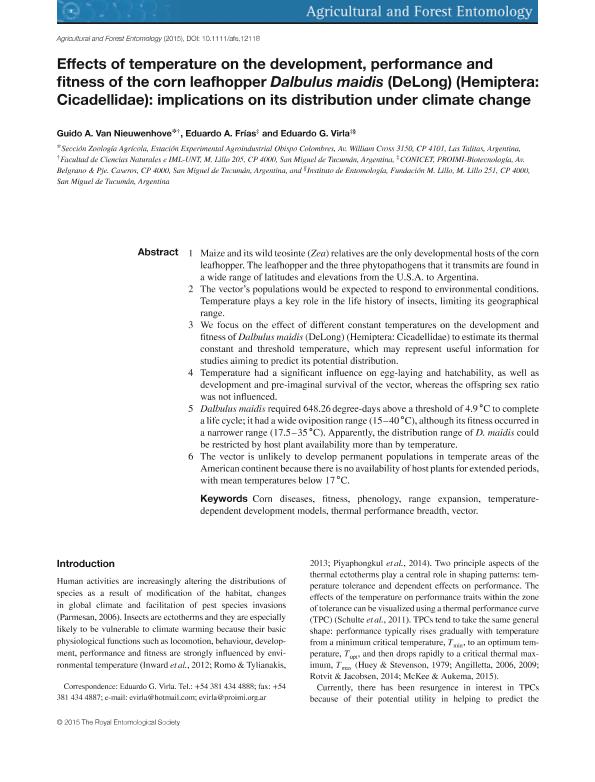Artículo
Effects of temperature on the development, performance and fitness of the corn leafhopper Dalbulus maidis (DeLong) (Hemiptera: Cicadellidae): implications on its distribution under climate change
Fecha de publicación:
02/2016
Editorial:
Wiley
Revista:
Agricultural And Forest Entomology
ISSN:
1461-9555
Idioma:
Inglés
Tipo de recurso:
Artículo publicado
Clasificación temática:
Resumen
1- Maize and its wild teosinte (Zea) relatives are the only developmental hosts of the corn leafhopper. The leafhopper and the three phytopathogens that it transmits are found in a wide range of latitudes and elevations from the U.S.A. to Argentina.
2- The vector’s populations would be expected to respond to environmental conditions. Temperature plays a key role in the life history of insects, limiting its geographical range.
3- We focus on the effect of different constant temperatures on the development and fitness of Dalbulus maidis (DeLong) (Hemiptera: Cicadellidae) to estimate its thermal constant and threshold temperature, which may represent useful information for studies aiming to predict its potential distribution.
4- Temperature had a significant influence on egg-laying and hatchability, as well as development and pre-imaginal survival of the vector, whereas the offspring sex ratio was not influenced.
5- Dalbulus maidis required 648.26 degree-days above a threshold of 4.9 ∘C to complete a life cycle; it had a wide oviposition range (15–40 ∘C), although its fitness occurred in a narrower range (17.5–35 ∘C). Apparently, the distribution range of D. maidis could be restricted by host plant availability more than by temperature.
6- The vector is unlikely to develop permanent populations in temperate areas of the American continent because there is no availability of host plants for extended periods, with mean temperatures below 17 ∘C.
Palabras clave:
Corn Disease
,
Fitness
,
Phenology
,
Range Expansion
Archivos asociados
Licencia
Identificadores
Colecciones
Articulos(PROIMI)
Articulos de PLANTA PILOTO DE PROC.IND.MICROBIOLOGICOS (I)
Articulos de PLANTA PILOTO DE PROC.IND.MICROBIOLOGICOS (I)
Citación
van Nieuwenhove, Guido A.; Frias, Eduardo Angel; Virla, Eduardo Gabriel; Effects of temperature on the development, performance and fitness of the corn leafhopper Dalbulus maidis (DeLong) (Hemiptera: Cicadellidae): implications on its distribution under climate change; Wiley; Agricultural And Forest Entomology; 18; 1; 2-2016; 1-10
Compartir
Altmétricas




